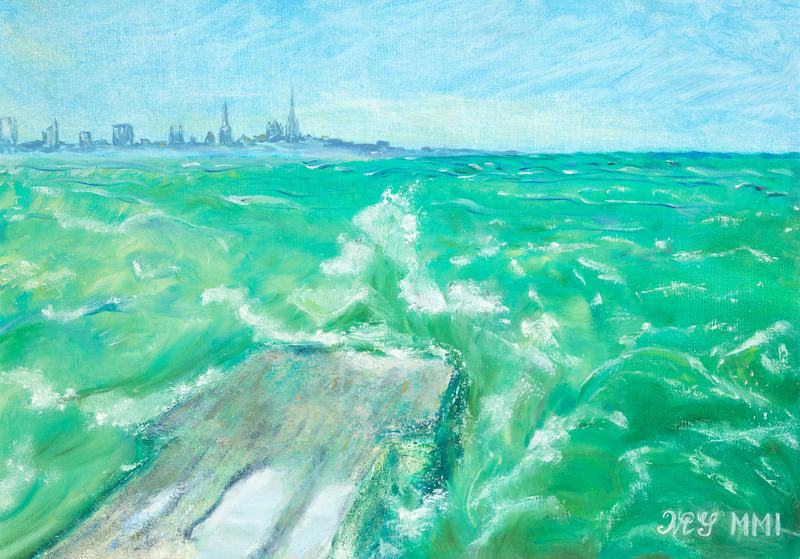A PORTRAIT OF I. K. AIVAZOVSKY
Sound track for the painting: Vanessa Mae. Summer Haze
Technique: oil on canvas, modeling paste Dimensions: 70 х 50 cm Style: Positive Synergism
This canvas depicts the same, but modern, Tallinn bay, which was made immortal by Ivan Konstantinovich Aivazovsky, a world-famous Russian marine artist, battle painter, art collector, violinist, and benefactor, in his chef-d'oeuvres of 1844, 1845, and 1898…
Where is his portrait? – Which portrait? HE is the sea… The sea is paradoxical: even in bad weather and storm, it gives ‘calmness and willpower’… Moreover, everything connected with Ivan Aivazovsky is paradoxical, too! There might happen this kind of Genius!
Being Russian… he was born into an Armenian family of Gevorg Aivazian and his wife Ripsime; on his mother’s side he was a great grandson of a Turkish general’s son, who still a child was saved from death by an Armenian when the Russian army captured the Turkish fortress of Azov in 1696. Later the Armenian baptized and adopted the child…
Being a painter… he many times participated in battles and military exercises…
Being world famous… he refused to live in capitals, and the fact even caused his divorce with the first wife…
He lived in a modest town of Feodosia… but his estate Shah-Mumuy was ‘posh, a bit like a fairy-tale; such property probably might be seen in Persia’…
He was a friend of Alexandre Pushkin, but never read him…
He was not a composer, but together with Mikhail Glinka, he was writing Ruslan and Lyudmila…
And after all these, Anton Chekhov wrote about him: ‘Aivazovsky himself is a hale and hearty old man of about seventy-five, looking like an insignificant Armenian and a bishop at the same time; he is full of a sense of his own importance, has soft hands and shakes your hand like a general. He is not very bright, but he is a complex personality, worthy of a further study. In him alone there are combined a general, a bishop, an artist, an Armenian, a naive old peasant, and Othello. He is married to a young and pretty woman, on whom he is keeping an iron grip. He is privileged to know sultans, sheikhs, and emirs... In all his lifetime, he has never read a single book. When he is offered to read, he says, ‘Why should I read if I have own opinions?’ And it hardly has anything to do with ignorance; it might be a quite normal difficulty of a dyslexic in learning to read or interpret words, letters, and other symbols, but that in no way affects general intelligence… Those days the notion of dyslexia did not exist, but for geniuses the condition is not a rare happening…
He loved the Black sea… However same passionately he was painting the Bosphorus, the Baltic Sea, the Sea of Marmara, and the Aegean Sea…
He was fond of helping people: he supplied the town with water from his own estate; he opened an art school; he built galleries; due to his effort, a commercial port was built in Feodosia… His contributions were generous… Nevertheless, he did not avoid gratitude, too… For example, at the fountain, which was an exact copy of the one in Constantinople, there was a silver mug with the inscription ‘To the health of Aivazovsky and his family’. Now the fountain bears his name…
Ivan Konstantinovich worked only two hours per day (early in the morning, at the sunrise; he particularly valued this type of lighting), but created more than 6 000 paintings…
Aivazovsky is copied a lot and often, but no one succeeded to surpass him… A famous English painter J.M.W. Turner was so struck by Aivazovsky's pictures The Bay of Naples on a Moonlit Night and The Disaster that he dedicated a rhymed eulogy to him:
And eventually, the last paradox: on a white marble sarcophagus of a genius Russian painter a quote from Movses Khorenatsi's History of Armenia in Classical Armenian is engraved: Մահկանացու ծնեալ անմահ զիւրն յիշատակ եթող (Mahkanatsu tsneal anmah ziurn yishatak yetogh), which can be translated as: ‘Born as a mortal, left the immortal memory of himself’. |
Pictures of the paintings: Sergrei Didyk
